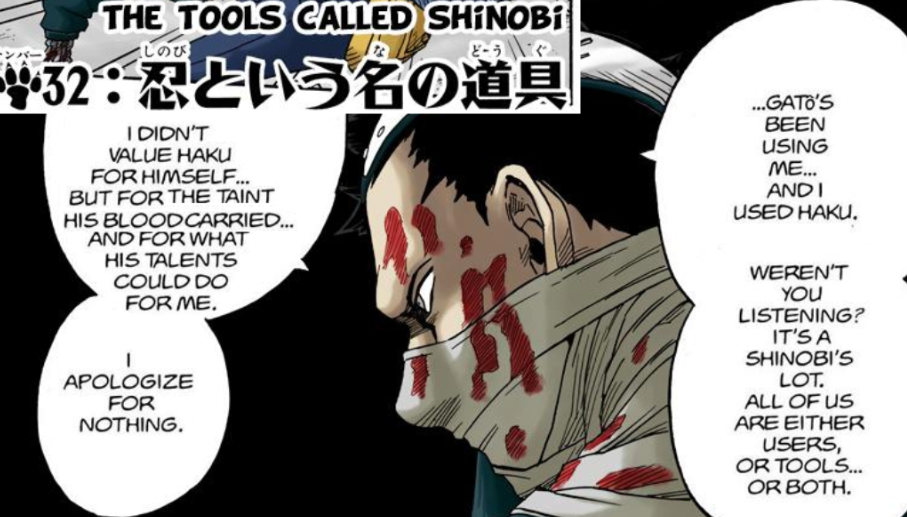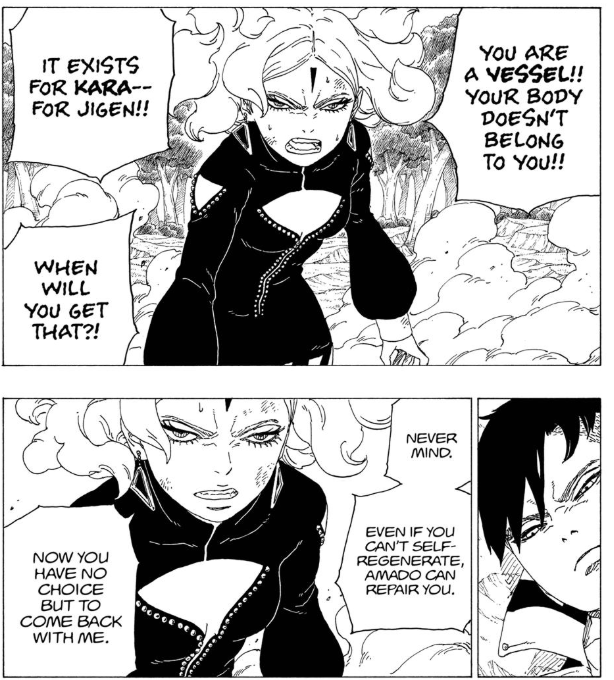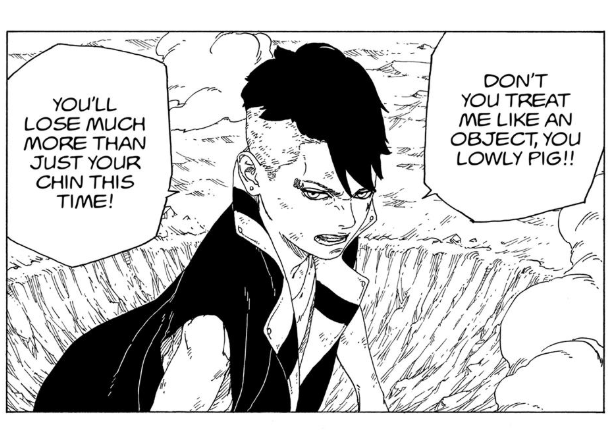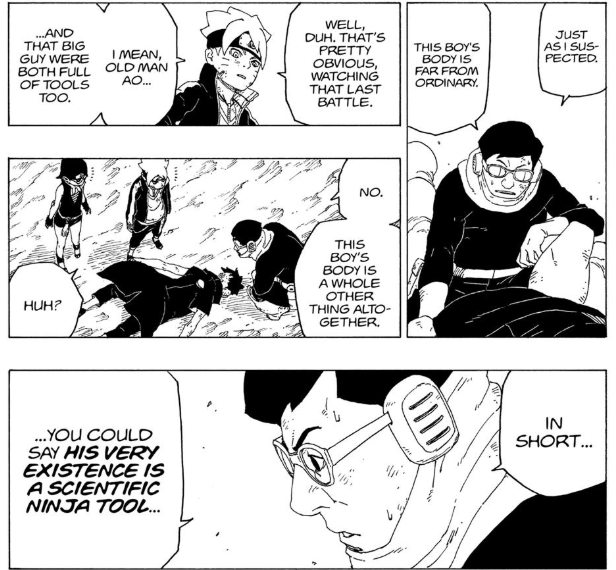The Scientific Ninja Tools Not Called Shinobi
warlic on shinobi and humans as tools

Happy Friday, all. Today, I'm turning the reins of the blog over to warlic (@warlic.bsky.social). Enjoy this exploration on the theme of humans as tools in Naruto and Boruto.
From the first arc of the original Naruto manga, one of the central conflicts was the inherent meaning of what it meant to be a shinobi, with Naruto refuting the notion they were little more than weapons. This theme is carried over into Boruto in an interesting way.
The first major antagonist of the series, Zabuza, espouses a philosophy that a shinobi is nothing more than a military asset, one that itself perpetuates the abusive cycle by using everyone else around them in that same manner. After his failed coup of his village of Kirigakure, Zabuza discovered the talented orphan, Haku, and began molding him as a living weapon in his quest to eventually overthrow Kiri.
As he describes to Team 7, Zabuza saw no utility in Haku aside from what he could offer as a tool for his scheme, and the child likewise felt no purpose outside of that framework. Yet, in the end, Zabuza was unable to kill his emotions and found himself caring for Haku, culminating in both of their deaths. Afterwards, Kakashi reiterates that a shinobi is someone who doesn't care about their own existence, but is instead a means to be used by others.Naruto rejects this premise and forms his nindō that carries him through the rest of the series. In summation, the first arc illustrates that the old corrupt shinobi system views shinobi as weapons, and Naruto, who seeks to essentially fix it, refuses that notion.

The idea of shinobi as tools immediately carries onto the next arc, the Chūnin Selection Examinations, in a number of ways. Not only are the exams essentially a proxy war between nations, using genin as stand-ins for an actual conflict, but in the Forest of Death, Sasuke is branded with Orochimaru’s juinjutsu, later called his “collar.,”which slowly binds him into Orochimaru’s thrall. Orochimaru wishes to use the Uchiha as a vessel, not treating him as his own person, but instead a tool for his immortality.
Likewise, Neji is branded with his own clan’s juinjutsu, which makes him feel he is fated to merely die at the whims of the Main House, but Naruto contests this, and it is ultimately revealed what Neji thought of the Hyuga clan was not exactly true.
Orochimaru’s callous outlook is furthered during the invasion of Konoha when he revives the previous two Hokage as mindless fighting machines, and he muses that this is the nature of shinobi that they “love,” though the Hokage cannot argue as they are brainwashed and forced to fight their pupil, Hiruzen. Hiruzen, for his part, is aghast not only at this unholy reanimation, but also its true nature that he finds when he manages to seal the two Hokage; the vessels sacrificed to summon them were none other than Orochimaru’s own underlings. Disgusted by his former student’s brazen use of shinobi as nothing but sacrificial pawns, Hiruzen finds his own Will of Fire blazing and manages to obstruct Orochimaru’s means of doing more harm by sealing his arms. Before he dies, Hiruzen tells Orochimaru that a shinobi’s true strength is present when they are protecting someone else. This stands in contrast with both Orochimaru and Zabuza’s apathetic view of shinobi as not needing emotions and is instead in line with Naruto’s refutation, indicating the Hokage and the genin are on the “right track” compared to the villains.
At the same time as this battle is occurring, Naruto and Gaara, two hosts of monsters, are in battle. Gaara, who was raised as nothing more than a human weapon by his father, transforms into the very monster his village feared, while Naruto, instead, using the bonds he forged with his own will and emotions, joins forces with the giant toad, Gamabunta. Alongside this, Naruto manages to derive power from his own monster, the Kyūbi, but unlike Gaara, he does this via negotiation instead of stifling his own will. It is through this will and alongside Gamabunta, that he emerges victorious. This clearly indicates that the shinobi approach of emotionless tools is ultimately folly, which is carried on through the rest of the manga.
After the invasion, more of Orochimaru’s henchmen, the Sound Four, arrive at Konoha to escort Sasuke to their master. The Sound Four tell him that as they are all branded by Orochimaru’s juinjutsu, the curse mark acts as a sign that they are merely his “pets,” not free by their own will, but instead tools for Orochimaru’s will. The strongest indication of this is their secret fifth member of the Sound Four, Kimimaro, who, like Haku, views his own life as having no meaning outside of being a tool for the snake Sannin, and sets out to prove his worth after he fails to be a vessel. Ultimately, all five of the shinobi sent by Orochimaru end up dead, though he is nonplussed as he has received his prize, Sasuke by his side. In contrast, the Konoha-nin manage not to lose a single member and are satisfied despite failing their mission, showing the contrast in their methodologies.
In Part II, the idea of shinobi as tools is expanded as it is revealed every village has their own hosts, the jinchūriki, literally meaning power of human sacrifice, which in a way is a summation of the corrupt view of shinobi as military assets and nothing more. The Akatsuki, a group of mercenaries that sell their services as tools across the shinobi world, seek these hosts out one by one. In most cases, the villages do not care that their jinchūriki are taken, aside from the loss of a military asset. However, the third host captured, Gaara, evokes a response from the bonds he had formed, and Team 7 comes to his rescue. Despite dying from having his bijū extracted, the summation of the emotional connections he has with others culminates in his revival when Chiyo sacrifices herself to resurrect him, a far-cry when Orochimaru sacrificed his own underlings to summon the Hokage as nothing more than weapons.
As Part II continues, the nature of the theme further expands. It is revealed that the leader of the Akatsuki, Pain, was himself manipulated by the true leader, Obito, who in turn was under the control of Madara from beyond the grave. No matter how deep it goes, it is always shinobi being used, or using others, just as Zabuza said. At the end of this chain is Black Zetsu, the manifestation of Kaguya’s will, a being who literally has no concern over its own existence and exists only as a tool to carry out its mission, the revival of its “mother.” Just as Madara manipulated others, Black Zetsu tells him he was not immune to manipulation himself, just like Zabuza was unable to escape the manipulations of Gatō all those years ago.
Black Zetsu stands as the very embodiment of the shinobi system that Naruto stands against, the ultimate evil both physically in relation to Kaguya and metaphorically in relation to his claim that all of shinobi history was his tool for Kaguya’s resurrection. With Kaguya’s defeat and Black Zetsu’s sealing alongside her, Naruto ultimately shows that his view is correct, that shinobi are not just tools; they are humans who live and die in accordance to their own will, and it is this view that succeeds the shinobi world in the New Era he ushers in.
Yet, the idea of shinobi as tools does not end there. Much like how Boruto similarly reframes Naruto’s refutation of predestination via a scientific lens whilst staying true to the thematics, Boruto takes the idea of shinobi as a weapon to an entirely new level.
The first material released for the Boruto New Era, Naruto Gaiden, features a science experiment of Orochimaru gone rogue, Uchiha Shin. Clones made from his own teeth, whom he also calls Shin, which he considered his “children.” Shin bears his own Sharingan that can even progress into Mangekyō, which bears the ability to leave brands with his touch that allows him to control whatever is branded telekinetically. Using this ability, he pulls his own “son” into the literal line of fire to protect himself when Sasuke shoots a fireball at him. That the ability appears to place a curse mark is fitting given his own lineage, as curse marks are one of the many ways shinobi use others as tools.
Later, when one of his internal organs ruptures from his battle with his foes, he uses his ability to perform surgery on himself and one of his clones, killing the latter to harvest his organs to save himself. Sakura is appalled by Shin’s actions, but he explains that despite being made from his own body, they are sources of flesh—nothing more, nothing less. Like Orochimaru before him, he uses his fellows as tools for his own agenda, either as literal human shields, or organ donors, but the nature of them being artificially created for that purpose instead of being metaphorically crafted begins to show the way that the theme will manifest in the future.
In the Boruto anime, Shizuma using Kagura as a tool for his planned coup of Kiri, not unlike Zabuza before him, is another sign of the tools called shinobi, but this theme does not really pick up until the battle with the Ōtsutsuki. Upon his death, Momoshiki brands Boruto with a Kāma, which is later revealed to be slowly transforming Boruto into Momoshiki, whose data will overtake him once the process is complete. In the interim, the Kāma grants Boruto with many abilities he did not have before, turning him into a being more akin to a weapon.
This is paralleled by Kawaki, a vessel for Kara that Team 7 encounters in a mission after Momoshiki’s death. Kawaki is modified down to the cellular level. Katatsuke, the leading scientist in Konoha, declares Kawaki to be a literal living weapon. Team 7’s attempt to escort him to Konoha is stymied by Garō, a modified human who is more obviously a cyborg than Kawaki, wielding offensive technology that is ultimately no match for Kawaki’s superior modifications in addition to his Kāma, the ultimate sign he is a living weapon.
This shows the way the New Era handles one of the ideas of what it means to be a shinobi. Despite the prevailing view of shinobi in the world now reflecting Naruto’s ideal, Kara acts as a counter to that view by literally producing living weapons that only exist to serve a specific function. In a way, despite having no formal training, these cyborgs adhere more closely to the classical idea of shinobi at the start of the Naruto manga in Part I than current shinobi do.
This ideological clash manifests in a physical clash when a superior in Kara, Delta, flies into Konoha to retrieve Kawaki. Exchanging words with Kara’s vessel, Delta is irate that Kawaki has developed his own will when he risks his own well-being for the Uzumaki family. As she tells him, he is a vessel whose body does not belong to him who exists only for Kara and its leader, Jigen. In this way, Delta acts as an analogue for the old shinobi ways, repackaged in a veneer of new technology. Delta herself, as it is later revealed, is a failed clone of her creator’s daughter, modified after said failure to be a living weapon to be used by Kara. This itself reflects the theme of the previous Ao arc, in which it is not the technology itself that defines its purpose or value, but how it is used. Despite having the highest level of technology, Kara’s worldview is backwards and outdated compared to Naruto’s, who ultimately overcomes Delta using the fruits of his training, which he gained from not being treated as a tool.



Kawaki's entrance into the Boruto series makes the theme of humans as tools even more literal.
Typically, Naruto’s victory against Delta would be a sign that his view is correct, reinforcing the themes of the original manga. However, in this case, it is not so simple. After the battle with Delta, another inner of Kara, Kashin Koji, betrays Kara and does battle with Jigen, forcing him to revive into Isshiki. Isshiki tells Koji that his purpose was nothing more than as a tool meant to die. Unlike with Naruto who won by his will, Koji is nearly killed by Isshiki, who tells him he was a sacrificial pawn by his fate. Shortly before this, Naruto was defeated by Jigen, and sealed in a vessel, which was handled by a fellow Inner of Kara, Boro. Team 7 confronts him, and he ends up using their emotions against them, distracting the team by targeting the vessel Naruto is sealed in, nearly resulting in their defeat. While they eventually overcome Boro at first, this only causes him to rampage. It was likely he would have killed them all if not for Boruto manifesting a further stage of his Kāma, acting as a tool for Momoshiki to manifest, killing Boro. If Boruto was not branded as the tool of someone else, which made him a weapon, they all would have died.
Afterwards, Jigen, now revived as Isshiki, confronts Konoha, culminating in a battle between him and Naruto, Kawaki, Sasuke, and Boruto, concluding in Isshiki’s death, but not without cost. All four present nearly died or worse, and Naruto had to sacrifice Kurama, while Sasuke lost his Rinnegan. Despite staying true to their ideals, the shinobi were clearly not equipped to handle the being who views others merely as tools to be used.
The encounters with Boro and Isshiki clearly shake Kawaki, who takes it upon himself to make sure that no more people have to risk themselves for his sake, sending him down a destructive cycle wherein he could be compared to a living nuclear bomb. At the same time, Code, the failed vessel of Isshiki who like Kimimaro before him having nothing more than his purpose for his master, seeks to finish the mission of his “God.” Seeking power to stop Code, Kawaki turns to the scientist who made all of the cyborgs of Kara, Amado, and has him implant a “weaponized Kāma,” unsubtly calling Kawaki a living weapon even more than he already was. It is in this capacity that Kawaki emerges victorious over Code and even “kills” Boruto. Afterwards, two additional cyborgs, more living weapons, appear in Konoha and through Kawaki, the Omnipotence is cast, shifting the view of the entire world. Now, it appears that Naruto is dead, and potentially, his view of shinobi along with him. The protector of Konoha becomes the living weapon, Kawaki. The traitor, Boruto, acts as a lightning rod of hatred for killing the Hokage.
After he flees from Konoha, Boruto meets up with Koji, the two becoming unlikely allies. Koji explains that he was willing to die as a tool just as Isshiki told him, yet with the manifestation of his ability, he felt his duty was incomplete and managed to escape, now acting to aid Boruto. After three years away, Boruto returns to Konoha, seeking to make things right as they were before. Now the Hitoshinju stand in the way, beings evolved from what were initially weapons made by Code, now seeking a greater purpose. Which way shall they fall, ultimately?
From a metaphor of cyclic abuse and manipulation, to the production of clones and cyborgs made to act under the commands of their masters, the meaning of a shinobi is both varied yet consistent. As Boruto said he would not let fate control him at the end of Part I, it is likely he will overcome the living tools and show once and for all that shinobi are more than weapons. It is by understanding the history of this theme that one can gain a greater appreciation for the struggles of shinobi and non-shinobi alike, foresee the character arcs Boruto, Kawaki, Delta, and Koji are on as the future spirals into a vortex.
Interested in writing for Kyodai? Check out our Submission Guidelines.
